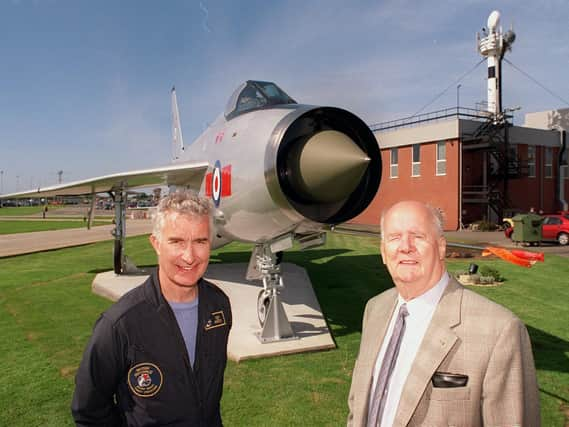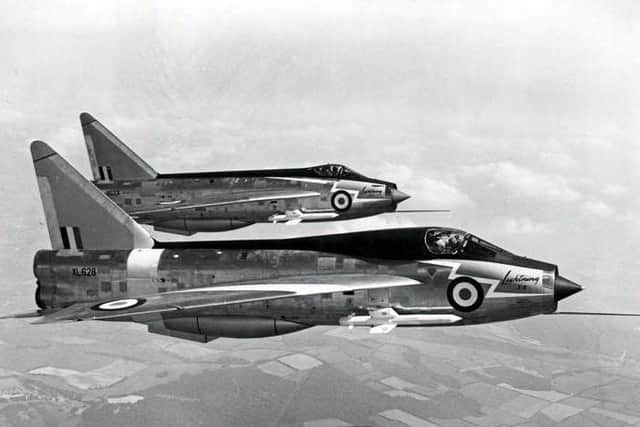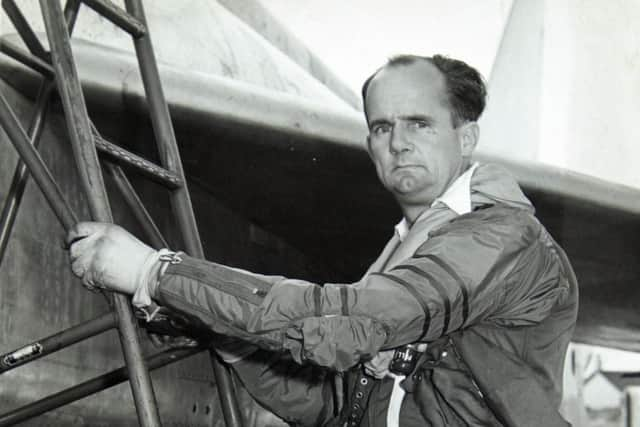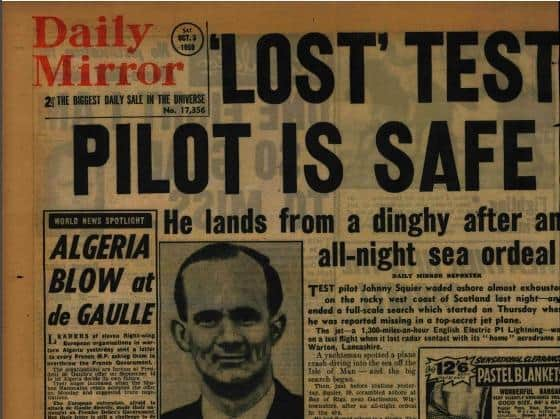Drama as supersonic pilot ejected into the Irish Sea


There were no dramatic problems during the development flying stage with the Lightning P1 series.
However, on October 1, 1959 test pilot John Squier was fortunate to escape death after ejecting from XL628, the prototype T4 two-seat variant, which had first flown from Warton on May 6.
Advertisement
Hide AdAdvertisement
Hide AdAt 11.15am on the morning of October 1, Squier took off from Warton and climbed to 35,000ft before accelerating to Mach 1.7 over the Irish Sea


His brief was to note engine data at every 0.1 Mach above Mach 1.0 to Mach 1.7, when he was to climb to 40,000ft, stabilize and make a 360-degree roll to starboard using maximum aileron with his feet off the rudder pedals.
This manoeuvre had previously been accomplished in single-seat Lightnings, but it had never before been tried in the two seat version. Squier reached Mach 1.7 and 20 miles due west of St Bees Head he carried out the aileron turn.
A high-speed roll immediately developed and when Squier, of Penwortham, centralised the controls to halt it XL628 yawed violently to starboard in a manoeuvre far fiercer than had previously been encountered during maximum aileron rolls in the single-seat Lightning.
Advertisement
Hide AdAdvertisement
Hide AdSquier knew a structural failure had occurred and the aircraft was now totally uncontrollable, yawing violently right and left and pitching. He had to get out, fast. He reached up, noticing as he did so that the pitot tube was bent right across the air intake and grabbed the seat blind; and the seemingly slow-motion ejection sequence was put in motion.


The canopy was whisked away into the void and the Martin-Baker seat fired him out of the doomed Lightning. As he exited, Squier took a blow to his right elbow from the SARAH (Search and Rescue Homing) battery and both his legs from his knees downwards were badly bruised by the ascent.
He tried to hold the blind to his face in the full force of the blast, which blew away his oxygen mask, but his arms were painfully wrenched away, almost out of their sockets.
Then the seat fell away but the parachute failed to deploy. Squier only became aware of this when he passed through cloud and could see the sea was getting ominously close. Instantly, he pulled the manual override and at last the parachute deployed.
Advertisement
Hide AdAdvertisement
Hide AdSquier plunged into the water and sank beneath the waves. He managed to inflate his life preserver and as he soared to the surface he became entangled in the shroud lines until he was able to disentangle himself and release the parachute.


Fortunately, the dinghy in the PSP (Personal Survival Pack) had inflated and it now floated invitingly nearby. He managed to clamber aboard but it was full of seawater and in the absence of the bailer he had to use a shoe to scoop out the water. Then he rigged the SARAH homing beacon and its aerial, but, to his dismay, the apparatus failed to work - the high-tension battery, which was one week beyond its inspection date, was flat.
For two hours Squier bobbed around on the sea before an amphibian approached. Squier managed to pull the pin on the two-star signal rocket, but it refused to fire and the aircraft failed to spot the tiny dinghy.
Another hour passed and the aircraft returned, but again the signal rocket failed to work. Ironically, the third and final rocket worked perfectly, but by now the amphibian had departed.
Advertisement
Hide AdAdvertisement
Hide AdSquier spent the rest of the day adrift on the sea and he must have begun to despair when darkness settled.
He had still not been found the next morning when rain and bad visibility cloaked the horizon. However, he could make out what he thought must be the east coast of Ireland (it was actually Wigtown Bay in western Scotland.) He tried paddling but all he succeeded in doing was going around in circles. A piece of driftwood helped and he eventually reached a point about 200 yards from the shore.
Finally, after passing ships hour after endless hour had seemingly ignored his whistles for help, Squier berthed alongside a tower in a small inlet and eventually managed to reach the shore, from where he was able to stumble to the safety of a house. In the garden was a matron from an adjoining school who told Squier she had seen the story concerning his disappearance in the newspapers.
He had spent 36 hours on the surface of the sea. Squier was rushed to Stranraer Cottage Hospital where, the next day, four doctors from the Institute of Aviation Medicine at Farnborough, who diagnosed two compressed vertebrae, examined him.
Advertisement
Hide AdAdvertisement
Hide AdHis eyes and middle ears had also haemorrhaged and he became deaf after a week - fortunately only temporarily. Two weeks later, he was airlifted from West Freugh to Warton and was admitted to Preston Royal Infirmary, where he spent another month.
The outcome of the investigation into the cause of the disaster found the thickening of the forward part of the fuselage to accommodate the second seat had reduced the Lightning’s stability, particularly with two Firestreaks attached.
It would be eight months before John Squier, who was also shot down during the Battle of Britain, was able to fly again.
The Men Who Flew The English Electric Lightning by Martin W Bowman is available from Pen and Sword priced £25.